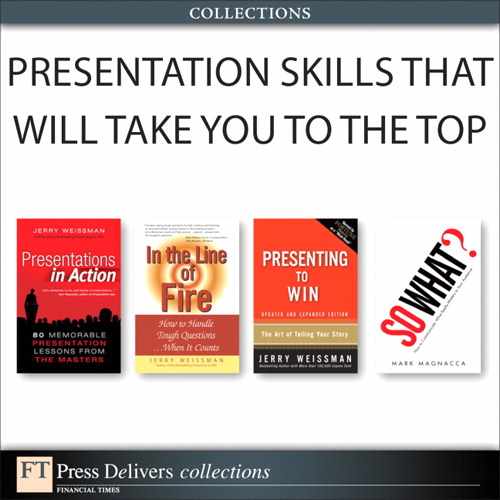12. The Elevator Pitch in One Sentence: How to Describe Your Business Succinctly
In a Wall Street Journal article about the Herculean tasks facing President Barack Obama—the economic crisis, the environment, health care reform, Iraq, Afghanistan, Iran, and North Korea—columnist Peggy Noonan referenced Clare Boothe Luce, a noted twentieth-century playwright, journalist, ambassador, and congresswoman. Ms. Luce “told about a conversation she had in 1962 in the White House with her old friend John F. Kennedy. She told him, she said, that ‘a great man is one sentence.’”
Ms. Noonan defined that one sentence as “leadership [that] can be so well summed up in a single sentence that you don’t have to hear his name to know who’s being talked about. ‘He preserved the union and freed the slaves,’ or, ‘He lifted us out of a great depression and helped to win a World War.’ You didn’t have to be told ‘Lincoln’ or ‘FDR.’”F12.1
As a conservative columnist and former speechwriter for Ronald Reagan and George H. W. Bush, Ms. Noonan said that Mr. Obama was replacing “his sentence with 10 paragraphs” and recommended that he should try to narrow his focus because “an administration about everything is an administration about nothing.” Jon Stewart, a longtime supporter of Mr. Obama, echoed Ms. Noonan on an episode of his The Daily Show, saying, “So, Mister President, while I am impressed with your Renaissance man level of knowledge in a plethora of subjects, may I humbly say, ‘That’s great! Now fix the economy!’”F12.2
The one-sentence recommendation is also applicable to business, with particular regard to the universally referenced elevator pitch—so named to refer to the way you’d describe your business if you stepped into an elevator and suddenly saw that hot prospect you’ve been trying to buttonhole. The allusion is intended to limit the pitch to the length of an elevator ride. Unfortunately, most such pitches in business are often as long as elevator rides in the Empire State Building, the equivalent of what Ms. Noonan calls President Obama’s “10 paragraphs.”
A guide to help you create a succinct elevator pitch can be found in the words of Rosser Reeves, a prominent advertising executive with the Ted Bates agency during the middle of the twentieth century.
Mr. Reeves coined the term “Unique Selling Proposition (USP),” defined in his biographical sketch in Advertising Age magazine as “the one reason the product needed to be bought or was better than its competitors.”F12.3
These USPs often took the form of slogans. Reeves oversaw the introduction of dozens of slogans, some that exist to this day, such as M&M’s® “Melt in your mouth, not in your hand.” He argued that advertising campaigns should be unchanging, with a single slogan for each product.
To pitch or describe your own business, develop your own USP along Rosser Reeves’s guidelines. One of the most common complaints about presentations is, “I listened to their pitch for 30 minutes, and I still don’t know what they do!”
The USP is what they do.
The one sentence Peggy Noonan recommended for Barack Obama would undoubtedly satisfy Jon Stewart—as well as every man and woman in America: “He brought America back from economic collapse and kept us strong and secure in the age of terror.”
